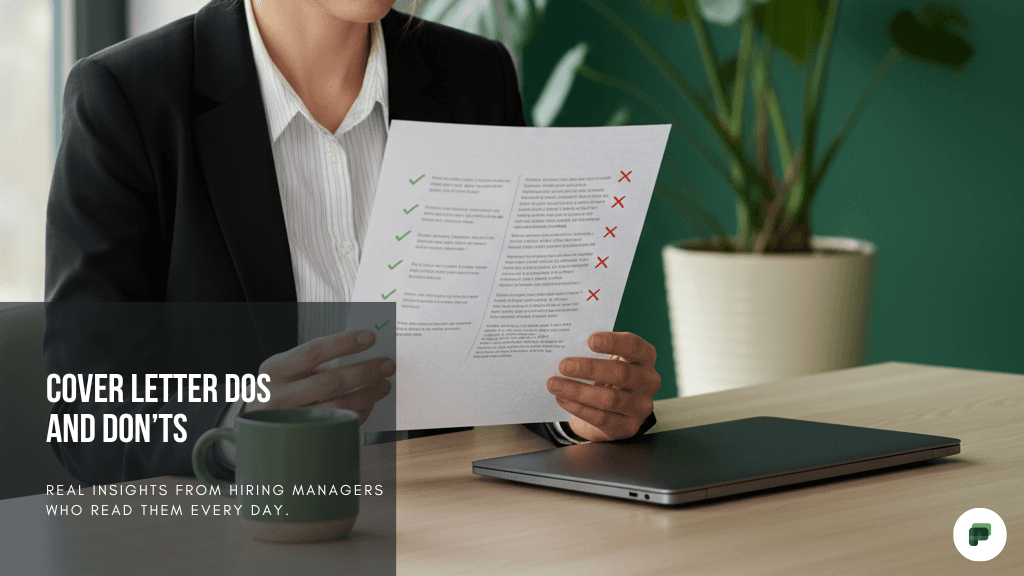Cover Letter Dos and Don'ts: Advice from Hiring Managers


Sneha Satapathy
Cover Letter Dos and Don'ts: Advice from Hiring Managers
TL;DR
Master cover letter excellence through proven DO strategies while avoiding critical DON'T mistakes that eliminate candidates. Hiring managers consistently value authentic storytelling, quantified achievements, and cultural alignment demonstration. Essential DOs include personalized research, strategic keyword integration, and confident value proposition articulation. Critical DON'Ts encompass generic salutations, resume repetition, and poor grammar/formatting.
Key Resources:
- Prepzo.ai Cover Letter Tools - Professional optimization platform
- Career Tools - Job application-specific guidance
Success lies in balancing professional structure with authentic personality, ensuring every element contributes to your unique value proposition and career narrative.
In today's hyper-competitive professional landscape, every element of your job application serves as a strategic differentiator. While digital transformation has revolutionized many aspects of career advancement, the cover letter remains a surprisingly powerful tool for professional distinction. At Prepzo.ai, our comprehensive research into hiring manager perspectives reveals that cover letters continue to play a decisive role in candidate evaluation and selection processes.
The data speaks volumes: 83% of hiring managers actively read cover letters, with 56% considering them essential for making informed hiring decisions. This isn't merely about demonstrating writing proficiency—it's about showcasing genuine interest, cultural alignment, and the unique value proposition you bring to the organization.
This comprehensive guide, informed by extensive research and direct insights from hiring professionals across industries, will equip you with evidence-based cover letter dos and don'ts that drive measurable results. We'll explore advanced strategies for moving beyond generic templates, effectively highlighting your professional achievements, and crafting compelling narratives that resonate with decision-makers.
The Strategic Importance of Cover Letters in Modern Hiring
Despite the proliferation of one-click applications and automated screening systems, cover letters maintain their strategic significance in professional recruitment. Hiring managers consistently report that these documents provide critical insights that resumes alone cannot deliver.
Understanding the Hiring Manager's Perspective
For talent acquisition professionals, cover letters serve as the primary indicator of a candidate's communication skills, attention to detail, and genuine interest in both the specific position and the organization. They offer a unique window into a candidate's personality, critical thinking abilities, and capacity for thoughtful professional engagement.
"A well-crafted cover letter immediately distinguishes serious candidates from those mass-applying to positions," explains a senior talent acquisition director at a Fortune 500 technology company. "It demonstrates respect for our time and the opportunity, while providing context that helps us understand the person behind the qualifications."
This sentiment resonates across industries, highlighting that the effort invested in personalized cover letter creation is often perceived as a direct measure of professional dedication and strategic thinking.
The Multifaceted Value of Strategic Cover Letters
Effective cover letters serve multiple strategic functions in your job search:
Career Transition Navigation: For professionals changing industries or roles, cover letters provide essential narrative space to clarify motivations and highlight transferable competencies that may not be immediately apparent from resume content.
Context and Clarification: They offer opportunities to address employment gaps, unconventional career paths, or specific circumstances that might otherwise raise questions during initial screening processes.
Soft Skills Demonstration: While resumes list capabilities like "communication" or "leadership," cover letters actively demonstrate these skills through clear, concise, and persuasive writing that showcases your professional voice.
Cultural Fit Communication: This is where your authentic professional personality can emerge, expressing genuine enthusiasm for the role while demonstrating understanding of the company's mission, values, and strategic objectives.
Competitive Differentiation: In markets where multiple candidates possess similar qualifications, a compelling cover letter can be the decisive factor that secures interview opportunities.
Critical Success Factors: What Hiring Managers Actually Value
Our extensive research reveals specific elements that consistently capture hiring managers' attention and positively influence their evaluation decisions. Mastering these critical success factors is essential for optimizing your cover letter's impact.
1. Authentic Personalization Over Template Usage
This represents the most crucial insight from our research. Hiring managers possess remarkable ability to identify generic, template-based cover letters within seconds of review. These typically feature vague language, absence of company-specific details, and an overall impression that the applicant hasn't invested effort in understanding the role or organization.
The detrimental impact of generic applications cannot be overstated. They signal disinterest, poor attention to detail, and potentially low engagement levels—qualities that immediately eliminate candidates from consideration. Conversely, personalized letters communicate thoughtfulness, professional diligence, and genuine enthusiasm for the specific opportunity.
2. Quantified Impact Statements Drive Credibility
Vague assertions about "strong communication skills" or "extensive experience" fail to create meaningful impressions. Hiring managers seek tangible evidence of your professional impact, expressed through specific metrics, outcomes, and measurable achievements that demonstrate your capability to create value.
For example, instead of stating "Improved operational efficiency," a compelling approach would be: "Redesigned workflow processes, resulting in 23% reduction in project completion time and $150,000 annual cost savings while maintaining quality standards." This provides concrete proof of capabilities and directly translates past success into potential future value.
3. Strategic Length Management for Optimal Impact
Hiring managers operate under significant time constraints, typically spending 30 seconds on initial cover letter review. This brief evaluation window necessitates concise, impactful content that can be quickly scanned and absorbed. The optimal length for professional cover letters is 250-400 words, typically contained within a single page.
This brevity requirement demands precision in language and strategic content selection. Every word must contribute meaningfully to your value proposition, with structure guiding readers effortlessly through your most compelling qualifications.
4. Opening Paragraph Excellence Determines Engagement
The initial paragraph represents your critical opportunity to capture attention and encourage continued reading. Research indicates that compelling openings increase the likelihood of complete letter review by 73%. This section must immediately establish relevance, value, and specific interest in the role while differentiating you from other candidates.
5. Company Research Integration Demonstrates Strategic Thinking
Candidates who invest time in comprehensive company research and integrate specific, relevant details into their cover letters significantly increase positive response rates. This extends beyond simple name recognition to include understanding of mission, recent achievements, strategic initiatives, or industry challenges that resonate with your professional experience.
6. Narrative Storytelling Creates Memorable Impressions
While resumes excel at listing qualifications and experiences, cover letters provide the canvas for strategic storytelling. A narrative approach that connects past experiences to future contributions, utilizing challenge-action-result frameworks, proves far more engaging and memorable than simple qualification listing.
Essential Cover Letter "Dos": Strategic Implementation Guide
Transform these insights into actionable strategies that elevate your application materials and increase interview opportunities.
DO: Create Compelling Value-Driven Openings
Your opening paragraph represents premium real estate in your application. Avoid generic introductions by immediately articulating specific enthusiasm for the role while highlighting a key qualification or achievement that directly addresses core job requirements.
Strategic Opening Example:
"As a Senior Marketing Manager with a proven track record of driving 40% revenue growth through data-driven campaign optimization, I was immediately drawn to the Digital Marketing Director position at [Company Name]. Your recent expansion into emerging markets aligns perfectly with my expertise in international brand development, and I am confident my experience scaling marketing operations can contribute significantly to your continued growth trajectory."
DO: Integrate Thoughtful Company Intelligence
Move beyond surface-level company mentions by incorporating details that demonstrate genuine research and strategic understanding. Reference recent developments, company values that resonate with your professional philosophy, specific products or services, or strategic directions that align with your expertise.
Company Knowledge Integration Example:
"Following [Company Name]'s recent announcement of your commitment to carbon-neutral operations by 2030, I am inspired by your leadership in sustainable business practices. My experience directing environmental compliance initiatives, including the successful implementation of a waste reduction program that decreased operational costs by 22% while achieving zero-waste certification, directly supports your environmental stewardship goals."
DO: Leverage Quantified Achievement Statements
Numerical evidence of your professional impact creates powerful credibility and helps hiring managers envision the tangible value you can deliver. Frame accomplishments with specific metrics whenever possible, focusing on outcomes that translate to business value.
Quantified Achievement Examples:
- Revenue Impact: "Generated $2.3M in new business revenue through strategic client relationship development"
- Efficiency Improvements: "Streamlined operations processes, reducing project delivery time by 35% while maintaining quality standards"
- Team Leadership: "Led cross-functional team of 15 professionals, achieving 98% project completion rate within budget constraints"
DO: Employ STAR Method for Concise Storytelling
The Situation, Task, Action, Result (STAR) framework enables you to provide compelling evidence of your capabilities through brief, relevant narratives. Select one or two powerful examples that directly relate to key job requirements.
STAR Integration Example:
"In my role as Operations Manager at [Previous Company], (Situation) our team faced declining productivity due to outdated workflow systems. (Task) I was tasked with redesigning operational processes to improve efficiency and team satisfaction. (Action) I led a comprehensive process analysis, implemented new project management software, and conducted team training sessions. (Result) These initiatives resulted in 30% productivity improvement and 85% increase in employee satisfaction scores within six months."
DO: Explicitly Connect Experience to Future Value
Avoid assuming hiring managers will automatically connect your background to their needs. Use your cover letter to clearly articulate how your specific skills, experiences, and achievements will enable success in the target role at their specific organization.
Connection Strategy Example:
"My comprehensive background in digital transformation initiatives, developed over eight years in the financial services sector, positions me uniquely to address the technology modernization challenges outlined for the IT Director role. My success in leading cloud migration projects that reduced operational costs by 25% directly translates to my ability to drive similar efficiency gains for [Company Name]'s infrastructure modernization goals."
DO: Optimize for Both Human and ATS Review
Modern hiring processes often involve Applicant Tracking Systems (ATS) before human review. Naturally integrate relevant keywords from job descriptions while maintaining readability and authentic voice. The Prepzo.ai cover letter generator can assist in identifying and incorporating appropriate keywords without compromising natural language flow.
Critical Cover Letter "Don'ts": Avoiding Application Killers
Understanding what to avoid is equally important as knowing best practices. These common mistakes can immediately undermine your application's effectiveness.
DON'T: Duplicate Resume Content
Your cover letter should complement and expand upon your resume, not repeat it verbatim. Use this space to provide context, share brief achievement stories, and inject personality into your professional narrative. If hiring managers wanted to re-read your resume, they would simply review that document.
DON'T: Use Generic Salutations or Impersonal Approaches
"To Whom It May Concern" or "Dear Sir/Madam" immediately signals generic application approaches and lack of research effort. Always attempt to identify the hiring manager's name through LinkedIn, company websites, or direct inquiry. When specific names aren't available, use "Dear Hiring Manager" or "Dear [Department] Team" as professional alternatives.
DON'T: Focus Primarily on Personal Career Goals
While career aspirations are natural, cover letters should emphasize what you can contribute to the organization rather than what the role can do for your professional development. Frame motivations and goals in terms of organizational benefit and mutual value creation.
Avoid: "I am seeking a role that will help me develop leadership skills." Instead: "I am eager to apply my project management expertise to drive [Company Name]'s strategic initiatives while contributing to team development and operational excellence."
DON'T: Include Irrelevant Personal Information
Maintain professional focus by excluding personal details that don't directly contribute to your candidacy. Avoid discussing hobbies, personal opinions, or information unrelated to professional qualifications unless it directly supports your application (such as relevant volunteer work that demonstrates applicable skills).
DON'T: Submit Without Thorough Proofreading
Grammar, spelling, or punctuation errors represent immediate red flags that suggest poor attention to detail and inadequate communication skills. Always conduct meticulous proofreading, ideally with fresh eyes after a brief break, and consider having trusted colleagues review your content before submission.
DON'T: End Without Strategic Call to Action
Your closing paragraph should extend beyond simple summary to include confident, professional calls to action. Reiterate interest while expressing enthusiasm for interview opportunities to discuss your qualifications in greater detail.
Effective Call to Action Example:
"Thank you for considering my application. I am enthusiastic about the opportunity to contribute my strategic planning expertise to [Company Name]'s continued growth and am confident I can deliver immediate value as your next Senior Operations Manager. I welcome the opportunity to discuss how my experience aligns with your team's objectives in a personal interview."
Industry-Specific Adaptation Strategies
While core principles remain consistent, successful cover letters require strategic adaptation based on your career stage and professional circumstances.
Career Transition Professionals
For professionals changing industries or roles, cover letters become critical narrative tools for explaining strategic career decisions and highlighting transferable competencies.
Strategic Approaches:
- Address transitions directly: Acknowledge your career change and explain the strategic reasoning behind your decision, framing it as purposeful professional evolution
- Emphasize transferable skills: Deconstruct past experiences into core competencies that apply across industries, providing specific examples of skill application
- Demonstrate proactive preparation: Highlight courses, certifications, volunteer work, or self-directed learning that prepares you for the new field
Recent Graduate Professionals
Without extensive professional experience, focus on demonstrating potential, readiness, and alignment with entry-level expectations while showcasing relevant academic and experiential learning.
Key Focus Areas:
- Academic project relevance: Highlight coursework, research projects, or capstone experiences that mirror real-world challenges in your target role
- Internship and volunteer impact: Treat these experiences as professional background, detailing responsibilities and achievements using STAR methodology
- Soft skill demonstration: Discuss leadership roles in student organizations, collaborative academic projects, or problem-solving initiatives that showcase professional readiness
Senior Professional Applications
Experienced professionals must emphasize strategic impact, leadership capabilities, and organizational vision while carefully avoiding perceptions of overqualification or misalignment with role requirements.
Strategic Emphasis:
- Strategic achievement focus: Highlight initiatives that impacted entire organizations, departments, or critical business functions
- Leadership and mentorship: Detail team building, talent development, and cultural transformation contributions
- Complex problem-solving: Describe sophisticated challenges overcome and measurable results achieved through strategic thinking
Technology Integration for Modern Cover Letter Excellence
In today's technology-enhanced hiring environment, strategic tool utilization can significantly improve your cover letter effectiveness while ensuring both human appeal and automated system compatibility.
The Prepzo.ai platform addresses many common hiring manager concerns through advanced AI-powered assistance that ensures personalization, ATS optimization, and professional quality standards. This technology-enhanced approach provides:
Intelligent Personalization: Advanced algorithms help integrate company-specific details and tailor messaging without requiring complete content recreation for each application.
ATS Optimization: Automated identification and natural integration of relevant keywords from job descriptions, increasing likelihood of passing initial automated screenings while maintaining readability.
Achievement Quantification: Structured prompts guide you toward including measurable outcomes and specific impact statements that transform generic claims into compelling evidence.
Professional Structure: Optimized formatting and flow ensure clear, scannable presentation that respects hiring managers' limited review time while maximizing information absorption.
Beyond cover letter creation, Prepzo.ai's comprehensive career tools enable enhanced company research, providing insights necessary for truly targeted content development. The platform's career coaching features also guide professionals in understanding hiring manager perspectives, enabling strategic application customization.
Systematic Cover Letter Development Framework
Implement this structured approach to ensure every cover letter meets professional standards and maximizes impact potential.
Phase 1: Strategic Research (15-20 minutes)
Job Description Analysis:
- Identify 3-5 critical keywords that appear frequently or seem most important
- Note specific responsibilities, required skills, and preferred qualifications
- Understand reporting structure and team dynamics when mentioned
Company Intelligence Gathering:
- Review "About Us," "Mission," and "Values" sections on company website
- Examine recent press releases, blog posts, or news coverage
- Check LinkedIn company page for recent updates and employee insights
- Research industry challenges or opportunities that may affect the organization
Hiring Manager Identification:
- Use LinkedIn to identify hiring manager or department head
- Check company website staff directories or team pages
- Consider calling reception for appropriate contact information
Phase 2: Strategic Content Development (30-45 minutes)
Theme Selection:
- Choose 2-3 most relevant experiences or achievements that directly address core job requirements
- Ensure selected themes align with company values and strategic objectives
- Prepare quantified examples that demonstrate measurable impact
Opening Paragraph Creation:
- State specific position interest and key qualifying achievement
- Reference company-specific detail that demonstrates research
- Establish immediate value proposition and relevance
Body Paragraph Development:
- Expand on chosen themes using STAR methodology for storytelling
- Explicitly connect past experiences to future contributions and role-specific challenges
- Demonstrate understanding of company priorities through industry research and strategic insights
- Quantify achievements with specific metrics that resonate with hiring manager priorities
Professional Closing:
- Summarize your unique value proposition in one compelling sentence
- Express genuine enthusiasm for contributing to specific organizational objectives
- Include a confident call-to-action that invites further conversation
- Maintain professional tone while showing authentic personality and career passion
Critical DON'Ts: Mistakes That Eliminate Candidates
Opening Paragraph Failures:
- Generic salutations like "Dear Sir/Madam" or "To Whom It May Concern"
- Weak openings that fail to capture attention or demonstrate research
- Immediate focus on what you want rather than what you offer
Content and Structure Mistakes:
- Repeating resume information without adding strategic context or insights
- Focusing solely on past achievements without connecting to future contributions
- Using passive language that diminishes your professional impact
- Including irrelevant personal information or unprofessional details
Communication Style Errors:
- Overly casual tone that doesn't match organizational culture
- Excessive use of industry jargon that obscures your actual qualifications
- Poor grammar, spelling errors, or inconsistent formatting
- Length extremes: either too brief to be compelling or too lengthy to maintain attention
Advanced Strategies for Competitive Advantage
Personalization That Stands Out
Company-Specific Research:
- Reference recent company achievements, initiatives, or industry recognition
- Demonstrate understanding of current business challenges and market position
- Connect your experience to specific departmental objectives or organizational goals
Role-Specific Insights:
- Address unique aspects of the position that excited your interest
- Explain how your background specifically prepares you for anticipated challenges
- Suggest potential contributions or improvements based on your industry knowledge
Cultural Alignment Demonstration
Values Integration:
- Showcase experiences that reflect company values and cultural priorities
- Use language and tone that mirrors organizational communication style
- Demonstrate understanding of company mission through specific examples
Professional Development: Prepzo.ai optimization tools help align your messaging with company culture and values.
Conclusion
Mastering cover letter best practices requires understanding both the explicit rules and subtle nuances that separate exceptional applications from standard submissions. The insights shared by hiring managers reveal consistent patterns in candidate evaluation, providing clear pathways for creating compelling, memorable cover letters.
Comprehensive Resources:
- Prepzo.ai Cover Letter Platform - Professional development tools
The most successful candidates understand that cover letters serve as strategic communication tools rather than simple application requirements. By implementing proven DO strategies while carefully avoiding common DON'T mistakes, you position yourself for significantly improved interview conversion rates and career advancement opportunities.
Remember that exceptional cover letters emerge from authentic professional storytelling, strategic positioning, and genuine enthusiasm for contributing to organizational success. Your investment in mastering these fundamentals pays immediate dividends through enhanced professional opportunities and accelerated career progression.
The difference between good and exceptional cover letters lies in the details—make yours impossible to ignore through strategic excellence and authentic professional presentation.
Frequently Asked Questions
Q1: How long should my cover letter be to maintain hiring manager attention?
A: The optimal cover letter length is 250-400 words, fitting comfortably on one page with professional formatting. Hiring managers typically spend 15-30 seconds on initial cover letter review, so concise, impactful content performs better than lengthy narratives. Focus on 3-4 compelling points rather than comprehensive career history. Each paragraph should serve a specific purpose: engaging opening, relevant qualifications, cultural fit demonstration, and confident closing.
Q2: Should I mention salary expectations or availability in my cover letter?
A: Generally avoid salary discussions in your cover letter unless the job posting specifically requests this information. Cover letters should focus on value proposition and qualifications rather than compensation expectations. If salary requirements are requested, provide a professional range based on market research: "My compensation expectations align with market standards for this role, typically ranging from $X to $Y based on industry research." Address availability only if you have specific constraints that might affect the hiring timeline.
Q3: How do I handle career gaps or job changes when writing my cover letter?
A: Address significant gaps or frequent job changes proactively but positively. Frame gaps as strategic choices that developed relevant skills: "During my career transition period, I completed advanced certifications in digital marketing while consulting for small businesses." For job changes, focus on growth progression and learning: "Each role provided expanding responsibilities and deeper expertise, culminating in my readiness for this senior position." Always connect these experiences to your qualifications for the current role.
Q4: What's the best way to research company culture to ensure my cover letter tone is appropriate?
A: Conduct comprehensive research using multiple sources: company website (especially About Us and Values pages), LinkedIn company page and employee posts, recent news articles and press releases, Glassdoor reviews for cultural insights, and industry publications mentioning the company. Pay attention to language style in their communications—formal organizations prefer conservative language, while startups may appreciate more casual, innovative expressions. Match their communication style while maintaining professionalism.
Q5: How do I make my cover letter stand out in a competitive job market without being gimmicky?
A: Stand out through substance rather than gimmicks: demonstrate specific company knowledge, quantify your achievements with compelling metrics, tell authentic stories that showcase your problem-solving abilities, use industry-specific language that shows expertise, and propose potential contributions based on your research. Avoid colored paper, unusual fonts, graphics, or overly creative formats unless applying for creative roles. Excellence in research, writing quality, and strategic positioning creates memorable impressions that lead to interviews.

Sneha Satapathy
Related Articles

Writing Standout Cover Letters for Engineers
Learn why engineers should still craft cover letters, with frameworks, real examples, and tools to showcase impact effectively
Sneha Satapathy

Cover Letter Power Words That Make Your Application Stand Out
Power words transform ordinary cover letters into compelling professional narratives, find out how.
Sneha Satapathy

Cover Letter for No Experience: How to Make an Impact
A comprehensive guide to write a cover letter with no experience or as a fresher.
Sneha Satapathy